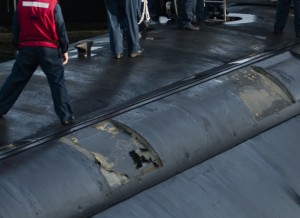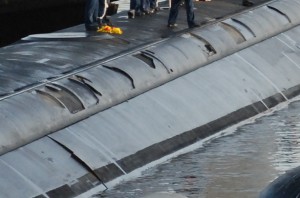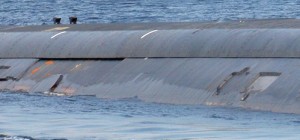 Submarines rely on stealth. And American Virginia Class submarines are considered the quietest, safest subs on the planet–it’s how the U.S. Navy justifies spending about $2 billion dollars for each of the two boats the nation wants to build every year.
Submarines rely on stealth. And American Virginia Class submarines are considered the quietest, safest subs on the planet–it’s how the U.S. Navy justifies spending about $2 billion dollars for each of the two boats the nation wants to build every year.
So…who would expect that the pricey subs–the foundation of America’s dominance under the seas–would suffer from a congenital skin problem? The Virginia’s sub skin, an innovative, cost-saving Mold-in-Place Special Hull Treatment (MIP/SHT), is failing–and it has been failing for years.
Look, I like the Virginias. The boats are nuclear-powered technological marvels, each capable of launching missiles and raining precision munitions on far-away targets. But we seem to have scrimped a bit on testing and de-bugging the special hull treatment–for those who don’t know, the MIP/SHT is the rubbery-ish insulation that helps the boat evade sonar, stay silent and, ultimately, survive. But the only problem is the hull treatment doesn’t stick to multi-billion-dollar hull. It comes off. In sheets.
I have written about this since late 2010. Here’s USS Texas, back in 2010:
Now, knowing the Virginias are peeling, it is quite funny to watch this week as folks decry the “minor” acoustic penalty imposed by the addition of the capability-enhancing Virginia Payload Module. You see, the Virginia Payload Module introduces a small “hump” in the sub–and the “hump”, by introducing complex currents, can make the ship a little easier to find. Cue hand-wringing, right? I mean it–I know for a fact that some Congressional Appropriators are gonna use this issue to keep the potentially ballistic-missile-ready VPM at bay until they can guarantee funds for a far more expensive–and, I suppose, humpless–SSBN.
Heck, I might even join the chorus of nay-sayers too–that is, if the current boats weren’t already swimming out of their protective coating, returning from a few days–DAYS (!!)–of deployment sporting noise-generating tears (flappers and bangers) and showing bare, active-sonar-loving metal. Some return so tattered that they look like old Soviet subs from the dying days of the Cold War. So, with the SHT/MIP suffering such dramatic failures, what’s a little extra hump-driven hydrodynamic perturbation?
Folks, flappers and bangers make noise. And if we’re going to make a program-delaying issue of the sound generated by the Virginia Payload Module, we darn well had best be treating the noise generated by the “Virginia Peel” in similar fashion. These hull treatment failures may not matter now–as we employ Virginias in Pirate Hunting or other low-risk ISR work, but, in a shooting war, that extra bit of current or loose bit of ripping SHT/MIP could be a matter of life or death.
Even the newest subs are having problems. Here’s the newly-delivered PCU Minnesota in August 2013, a mere two months post-sea trials, sporting her brand-new acoustic penalty:
And here’s USS Missouri (SSN 780) leaving port in June of 2013 for a deployment. Notice the rust? And just think about the interesting hydrodynamics going on back there…
Obviously, we have yet to solve the problem. It’s a known issue. DOT&E wrote about this three years ago. I picked it up, and detailed some of the more dramatic MIP/SHT failures here. The story then got advanced by Peter Frost in a Norfolk paper, where he summed up the issue nicely:
The specialized hull coating is designed to be “anechoic,” or able to absorb waves of active sonar so it does not bounce back to the ship or sub emitting the signal. It’s a crucial component to the stealth of the so-called “silent service,” making the sub more difficult to detect by adversaries.
Missing coating could diminish that effect, but the larger concern is the sound water makes as it flows over an uneven surface, said Norman Polmar, a naval analyst and author who has written about submarines.
“When pieces of the hull coating fall off, the sub gets noisier because it interrupts the water flow over the hull,” Polmar said. “When you put more noise in the water, you’re easier to detect.”
The Virginia Program Office, after getting a bit confused about when they actually identified the issue (either in 2006 or 2007), made soothing noises about how the MIP/SHT failures happened “over a period of years”. I promptly pulled out photos of the then-deployed USS Hawaii, and detailed how a localized MIP/SHT failure evolved into a far larger failure over the course of just a few days. Then Mother Jones went at the story. The Navy went into radio silence, but by early 2011, the Navy was dismissing the matter as solved, with Vice Admiral Kevin McCoy happily holding court in an interview with Peter Frost:
“Clearly we had problems on the early ships,” said Vice Adm. Kevin M. McCoy, commander of Naval Sea Systems Command, the Navy’s ship-buying and maintenance arm. “We think, for the most part, those issues are behind us.”
The loss of the specialized hull coating — designed to be “anechoic,” or able to absorb waves of active sonar so it does not bounce back to the ship or sub emitting the signal — could imperil underway submarines by making them easier to detect.
Despite those problems, McCoy insisted that the hull-coating failures have not contributed to operational issues for the submarines, saying “It’s not been a real big deal for us.”
McCoy said the Navy’s investigation revealed “no single smoking gun,” and that he’s “very confident going forward” that the Navy’s fast-attack submarines will retain the thick black coating that helps keep them silent and stealthy.
Affected submarines are being fixed during their normal dry-dock maintenance periods.
What’s frustrating is that the Minnesota’s Keel was laid a few months after this interview. After, you know, the Navy had “solved” the problem. It suggests that the Navy does not have a good handle on the root cause, or some workers someplace are not being rigorous in controlling the application process. And that is deeply, deeply distressing.
Sure, vets can tell us all about how that, in their day, huge numbers of hull-coating bricks would peel away during a single cruise. But that’s the point. A brick is a single piece–it can be replaced. The MIP/SHT on the Virginias is put into place as a largely unitary system–fixing and replacing it is hard. And expensive. And it puts sailors at risk.
So, if we’re not enduring this embarrassing hull coating failure for some secret squirrel operational reason, let’s apply some energy in fixing it. The Virginias are multi-billion-dollar assets. We’ve had several years to ID the root causes and find a fix. If we don’t have that fix yet, then slow the production line down until we actually have a solution in hand. The reason for doing this is as simple as it gets. On modern battlefields, a noisy sub is a dead sub. And that, dear readers, is unacceptable–a fact that all of us–the Navy, the sub builders and even our divided Congress–can agree on.




{ 2 comments… read them below or add one }
Well, you gotta give them credit–they are trying a new system, and, as history shows, we (the world) suffered mightily getting “alberich” tiles to adhere properly. It’s just that those neat Seawolf Class subs sure don’t seem to be having those problems (of course, they’re kinda kept out of the limelight, so we wouldn’t necessarily know)….Just feels like we didn’t march smartly through the research/testing/systems engineering process with this newish coating method. And that is distressing.
The amazing thing is that this was already a problem with the original “Alberich” coatings of 1944 and the Russians had the same problems.